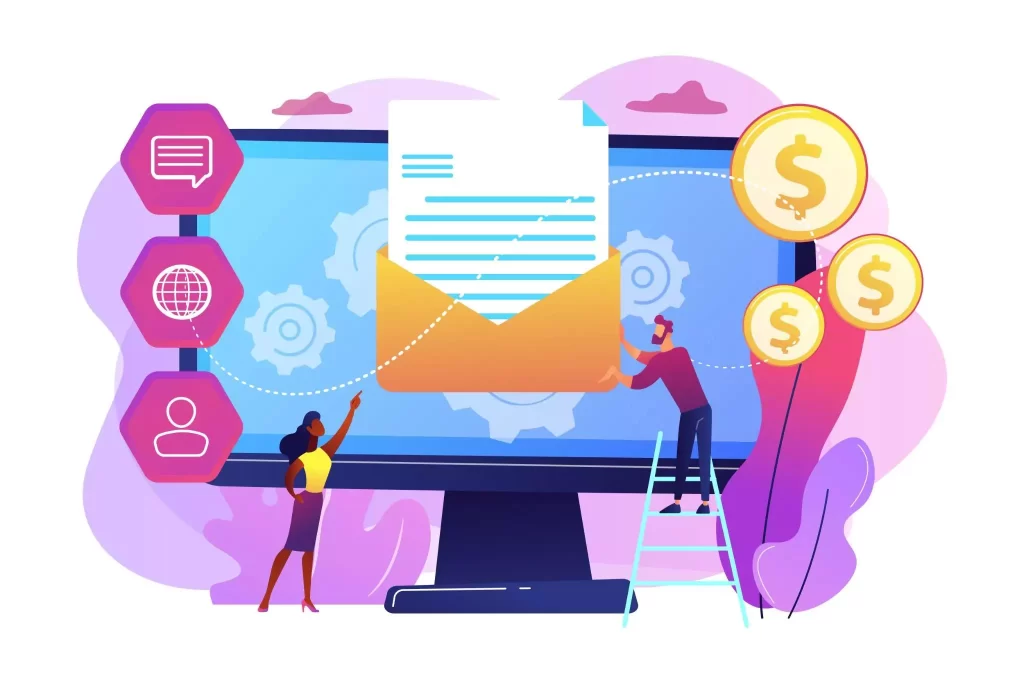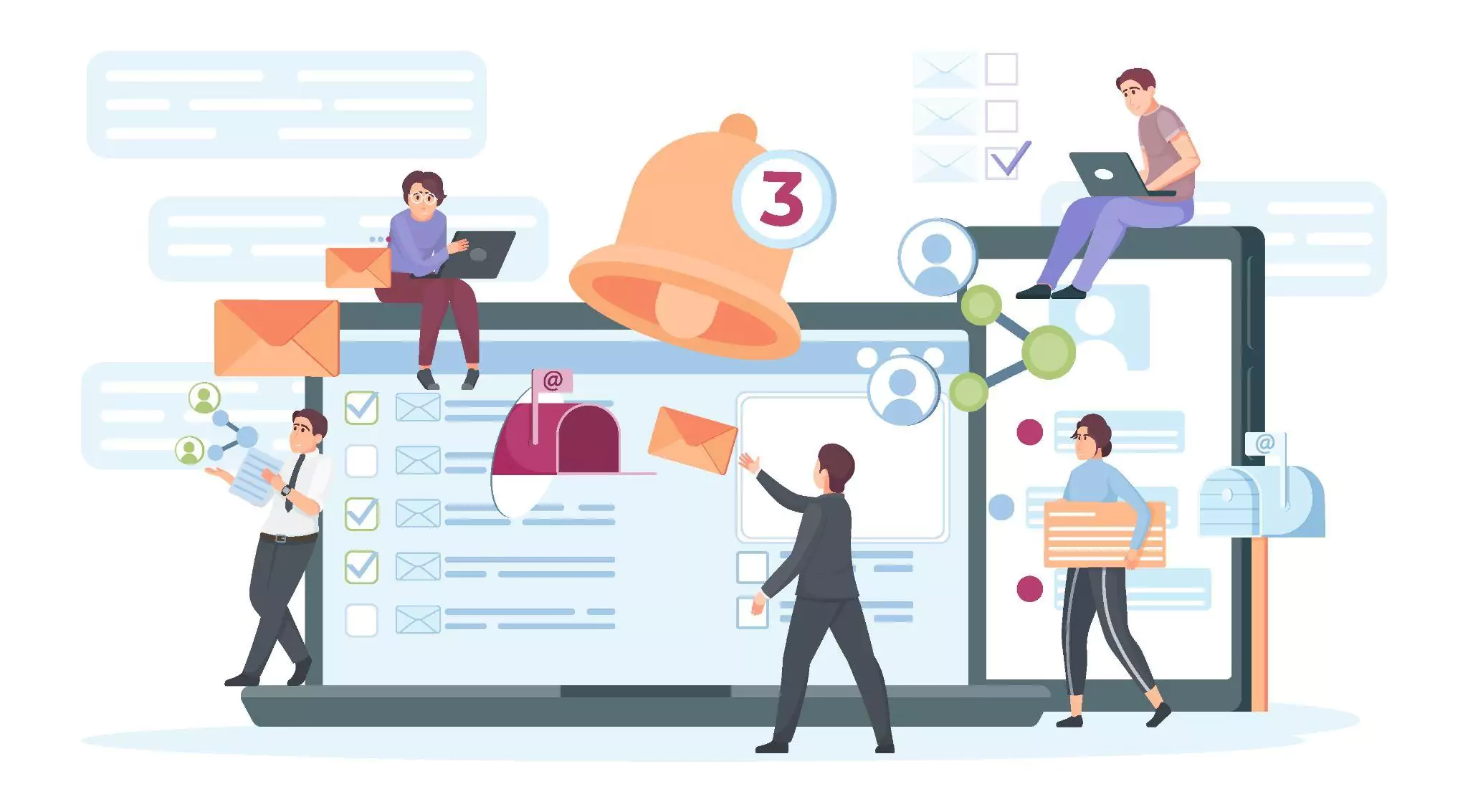Struggling to keep up with the rapid changes in email marketing? You’re not alone. With over 80 percent of businesses turning to this effective strategy, it’s more important than ever to stay current.
This blog post will provide you with an overview of the latest trends and techniques in email marketing, helping your business harness its full potential. Don’t miss out on pressing “send” for success!
Key Takeaways
- Email marketing has evolved, with personalized and visually appealing emails becoming more common. Mobile optimization is also essential as more people read emails on their phones.
- Personalization in email marketing is crucial for success. Customizing content and offers based on individual preferences increases customer engagement and builds trust.
- Automation helps streamline email marketing efforts with the help of email automation software or cold email software, saving time and allowing for personalized campaigns. Automated email campaigns, triggered emails, and analytics are valuable tools for achieving efficiency and improving engagement.
- Interactive email designs enhance engagement by incorporating elements like surveys, games, and quizzes. Visual content like videos and infographics also contribute to a more immersive experience for subscribers.
The Evolution of Email Marketing
Email marketing has changed a lot over time. In the past, businesses sent the same email to everyone on their list. But now, emails are often made for one person at a time. This is because we know more about each person who gets an email.
We can use this knowledge to make emails that speak to them.
The ways we send and design emails have also grown. Emails used to be simple text messages. Now, they can have pictures or even videos in them! They might look like a web page or a game you can play right in your email box.
Mobile phones have made big changes too. More people read their emails on their phones now than ever before. So making sure our emails look good and work well on phones is very important.
Artificial Intelligence (AI) is another big change that’s coming up fast! AI helps us know when and what kind of email someone will want most – without having to do all the hard work ourselves!
Even with all these new trends and tools coming into play, some things don’t change though: People still love getting valuable content right into their inbox!
The Rise of Personalization in Email Marketing
Email marketers are recognizing the importance of personalization in their campaigns, tailoring content and offers to individual recipients for a more engaging experience.
Importance of personalization
Personalization makes emails special. It means making an email feel like it was made for one person, not many. This can make someone more likely to open an email or click a link inside it.
Many businesses find that personalizing their emails helps them do better.
There are lots of ways to use personalization in your emails. You might use the customer’s name or talk about things they have bought before. Some companies also send out special offers based on what each person likes most.
Both humans and computer programs can help with this job.
Customized content and offers
Customized content and offers make emails more useful. These types of emails feel personal. They are not the same for all customers or subscribers. Businesses know what each person likes, needs, or wants with data analytics.
Then they only email them about those things that interest them. This increases customer engagement and helps small businesses sell more products or services online. It shows customers that the business knows who they are and cares about their likes and dislikes, which builds trust over time.
Dynamic email content
Dynamic email content is a powerful technique used in email marketing to personalize and enhance the subscriber’s experience. With dynamic content, you can create emails that adapt to each recipient based on their preferences and behaviors.
This means that each subscriber receives targeted and relevant information that resonates with them, increasing the chances of engagement and conversion. By utilizing dynamic email content, businesses can segment their audience effectively and deliver tailored messages that meet their specific needs.
With the rise of personalization in email marketing, dynamic content has become an essential tool for creating impactful campaigns that drive results.
For example, through dynamic email content, you can showcase personalized product recommendations based on past purchases or browsing history. You can also use it to display different offers or discounts based on the recipient’s location or previous interactions with your brand.
This level of personalization not only grabs attention but also creates a sense of exclusivity for the subscribers.
Automation in Email Marketing

Automation in email marketing has revolutionized the way businesses communicate with their customers. With its numerous benefits and potential for increased efficiency, automation is a game-changer in the industry.
Benefits of automation
Automation in email marketing offers several benefits that can enhance the effectiveness of your campaigns and save you time.
- Improved Efficiency: Automation allows you to set up workflows that automatically send emails based on specific triggers or actions, such as welcome emails for new subscribers or abandoned cart reminders. This saves you from manually sending individual emails, freeing up time for other tasks.
- Personalization at Scale: With automation, you can create personalized email campaigns tailored to different segments of your audience. By leveraging customer data and behavior patterns, you can send targeted messages that resonate with recipients and increase engagement.
- Increased Engagement: Automated emails can be timed to reach subscribers at optimal moments, increasing the likelihood of them being read and acted upon. By delivering relevant content and offers based on user preferences, automation helps drive higher open rates, click-through rates, and conversions.
- Enhanced Customer Experience: By automating certain processes like order confirmations, shipping notifications, and post-purchase follow-ups, you can provide a seamless experience for your customers. This not only improves their satisfaction but also builds loyalty and encourages repeat business.
- Data-driven Insights: Automation tools often come with robust analytics capabilities that provide valuable insights into the performance of your email campaigns. You can track metrics like open rates, click-through rates, conversion rates, and more to optimize your strategies and refine your messaging over time.
Using Email Automation Software or Cold Email Software
Email automation software enables you to set up automated email sequences that nurture leads and guide them through the customer journey.
By creating a series of personalized emails triggered by specific actions or time intervals, you can build stronger relationships with your subscribers and move them closer to making a purchase. This hands-off approach saves you time and effort while delivering consistent and timely communication to your audience.
On the other hand, Cold email software is also a powerful tool that allows you to reach out to potential customers who may not be familiar with your brand. With the right software, you can automate personalized cold email campaigns, ensuring that your message reaches the right people at the right time.
By leveraging this technique effectively, you can generate new leads, build relationships, and expand your customer base.
Automated email campaigns
Automated email campaigns are an important part of modern email marketing strategies. They help businesses save time and reach their audience more efficiently. Here are some key benefits and features of automated email campaigns:
- Time-saving: Automated email campaigns allow businesses to set up emails in advance, so they are sent automatically at the right time. This saves time compared to manually sending individual emails.
- Personalization: With automation, businesses can personalize their emails based on customer data and behaviors. This personal touch helps build a stronger connection with subscribers.
- Triggered emails: Automation allows businesses to send emails based on specific triggers, such as a customer’s birthday or when they abandon their shopping cart. These targeted messages increase engagement and conversions.
- Drip campaigns: Drip campaigns are a series of automated emails sent over time to nurture leads and guide them through the sales funnel. This helps businesses stay top-of-mind with their audience and drive conversions.
- Improved segmentation: Automation tools enable businesses to segment their email list based on various criteria like demographics, behavior, or purchase history. This ensures that subscribers receive relevant content tailored to their interests.
- A/B testing: Automation platforms often offer A/B testing capabilities, allowing businesses to test different versions of their emails to see which performs better. This data-driven approach helps optimize campaign effectiveness.
- Analytics and reporting: Automation tools provide detailed analytics and reporting on open rates, click-through rates, and other metrics for each email campaign. This data allows businesses to measure performance and make informed decisions for future campaigns.
Triggered emails
Triggered emails are automated messages that are sent to subscribers based on specific actions or events. They can be highly effective in engaging with customers and driving conversions. Here are some key points about triggered emails:
- Personalized communication: Triggered emails allow businesses to send tailored messages to individual recipients, based on their behavior or preferences. This personalization can help increase open rates and click-through rates.
- Timely follow-ups: Triggered emails can be set up to automatically send follow-up messages after a specific action, such as making a purchase or subscribing to a newsletter. These timely messages keep customers engaged and encourage them to take further action.
- Abandoned cart reminders: One common type of triggered email is the abandoned cart reminder. When a customer adds items to their shopping cart but doesn’t complete the purchase, an automated email is sent to remind them and potentially offer incentives to persuade them to complete the transaction.
- Welcome emails: Another important type of triggered email is the welcome email, which is sent when someone signs up for a newsletter or creates an account. This initial communication helps establish a connection with new subscribers and sets the tone for future interactions.
- Order confirmations and shipping updates: Triggered emails can also be used to provide customers with order confirmations and shipping updates. These transactional emails keep customers informed about their purchases and build trust in the brand.
Interactive Email Designs

Interactive email designs are a highly effective way to boost engagement and create an immersive experience for your subscribers.
Engaging and interactive elements
Engaging and interactive elements are becoming increasingly important in email marketing. With the rise of personalization, businesses need to find new ways to capture the attention of their subscribers.
By incorporating interactive elements like surveys, polls, and quizzes into emails, companies can actively engage with their audience and gather valuable feedback. Gamification is also a popular trend in email marketing, where brands use games or challenges to encourage user participation and boost engagement.
These interactive features not only make emails more enjoyable for recipients but also increase click-through rates and conversions.
Another effective way to enhance engagement is by including dynamic content in emails. This means tailoring the content based on each recipient’s behavior or preferences. For example, marketers can send personalized product recommendations or showcase different offers based on a customer’s recent browsing history.
By delivering relevant content that aligns with individual interests, businesses can create a more personalized experience for subscribers and increase the likelihood of conversion.
Gamification in emails
Gamification in emails is a strategy that uses interactive elements to increase engagement with the recipients. By incorporating games, quizzes, or challenges into email content, businesses can make their emails more fun and appealing to customers.
Gamification not only grabs attention but also encourages users to spend more time interacting with the email and brand. This can lead to increased click-through rates, higher conversion rates, and improved customer loyalty.
With the rising popularity of gamification in marketing strategies, businesses can leverage this technique to stand out in crowded inboxes and create memorable experiences for their audience.
Feedback and surveys
Feedback and surveys play a vital role in email marketing. They allow businesses to gather valuable insights from their subscribers and improve the effectiveness of their campaigns.
By collecting feedback, companies can understand what their audience wants and tailor their emails accordingly. Surveys also provide an opportunity to engage with customers and make them feel heard, strengthening the relationship between the brand and its audience.
Furthermore, incorporating feedback and survey responses into future email campaigns helps businesses refine their strategies and deliver more personalized content that resonates with subscribers.
The Impact of Visual Content
Visual content plays a crucial role in email marketing, capturing the attention of recipients and increasing engagement. Infographics and visuals in emails make information more digestible, while video content brings messages to life and enhances the overall impact of campaigns.
Importance of visual content
Visual content plays a crucial role in email marketing. It helps to grab the attention of subscribers and make your emails more engaging. When you include visuals like images, infographics, and videos in your emails, it can increase click-through rates and conversions.
Additionally, visual content is easily digestible and memorable, making it more likely for recipients to remember your brand and message. Research shows that emails with personalized visuals receive higher engagement compared to plain text emails.
So, if you want to make an impact with your email marketing campaigns, incorporating visually appealing content is key.
Infographics and visuals in emails
Infographics and visuals in emails can greatly enhance the effectiveness of your email marketing campaigns. Including visual content such as infographics, images, and videos can grab your subscribers’ attention and make your emails more engaging.
Visuals are a powerful tool for communication, as they can convey information quickly and effectively. Infographics, in particular, are an excellent way to present complex data or concepts in a visually appealing and easily understandable format.
By incorporating these visual elements into your emails, you can increase user engagement and encourage recipients to take action.
Including visuals also helps break up the text-heavy nature of traditional emails, making them more visually appealing and easier to digest. Research shows that people tend to be drawn towards visual content over plain text, so using graphics in your emails can significantly improve their impact on readers.
Moreover, adding relevant images or videos can provide additional context to the message you are trying to convey.
With the growing popularity of mobile devices for accessing email, it is important to optimize visual content for smaller screens. Ensure that any images or videos used in emails are mobile-friendly and load quickly on mobile devices.
This will help ensure that all recipients have a positive experience when viewing your emails regardless of the device they use.
Video content in emails
Video content in emails is a powerful tool for engaging subscribers and boosting conversion rates. Including videos in your email campaigns can grab recipients’ attention and provide them with valuable information or entertainment.
According to studies, emails that include videos have higher click-through rates and increased conversions compared to those without videos. This is because videos are visually appealing and can convey messages more effectively than text alone.
With the increasing popularity of video platforms like YouTube and TikTok, incorporating video content into your email marketing strategy can help you stay ahead of the competition and connect with your audience in a more meaningful way.
In addition, video content allows you to showcase products or services in action, provide tutorials or how-to guides, share customer testimonials, or even deliver personalized messages from your team.
It adds an interactive element to your emails that keeps readers engaged and interested in what you have to offer. However, it’s important to optimize your video content for email by keeping the file size small so it doesn’t slow down load times or get blocked by spam filters.
Mobile Optimization in Email Marketing
Mobile optimization is crucial in email marketing to ensure that emails are responsive and easily readable on mobile devices. With the increasing use of smartphones, businesses need to adapt their email designs to provide a seamless experience for mobile users.
Mobile-friendly layouts and responsive email designs enable recipients to open, read, and interact with emails effortlessly on their phones. Ignoring mobile optimization can lead to frustrated recipients who may delete or ignore emails that don’t display correctly on their devices.
To learn more about how you can optimize your email marketing for mobile devices, continue reading.
Responsive email designs
Email designs that adapt to different screen sizes and devices
- Ensures emails look great on mobile phones, tablets, and desktop computers
- Increases user experience and engagement
- Reduces the chances of recipients deleting or ignoring emails due to poor formatting on their device
- Helps businesses reach a wider audience who access their emails on mobile devices
- Supports mobile optimization efforts in email marketing campaigns
- Over 50% of emails are opened on mobile devices.
- Mobile-friendly layouts have higher open and click-through rates.
- Responsive designs provide a consistent experience across different platforms.
- They improve the visibility of call-to-action buttons and links.
- They contribute to a better overall user experience.
- Use email templates that are responsive by default.
- Test your emails across various devices before sending them out.
- Optimize images and graphics for faster loading times on mobile.
Mobile-friendly layouts
Mobile-friendly layouts are essential in email marketing to ensure that your emails display properly on mobile devices. Here are some key considerations for mobile optimization:
- Responsive design: Create emails with responsive designs that automatically adjust to fit different screen sizes. This ensures that your emails look great and are easy to read on both large and small screens.
- Clear and concise content: Mobile screens have limited space, so it’s important to keep your email content short and to the point. Use concise text, bullet points, and headers to make your message easily scannable.
- Large fonts and buttons: Opt for larger font sizes and buttons in your emails to make it easier for mobile users to read and interact with your content. This helps avoid accidental clicks or taps on small elements.
- Single-column layout: Instead of using multiple columns in your email design, stick to a single-column layout. This ensures that the content flows smoothly without requiring horizontal scrolling on mobile devices.
- Optimized images: Compress images to reduce file size without compromising quality. This helps improve load times, especially on slower internet connections or when users are on the go.
- Minimalistic design: Keep your email design clean and clutter-free on mobile devices by minimizing distractions. Use white space strategically to create a visually appealing and easy-to-read layout.
Importance of mobile optimization
Mobile optimization is a crucial aspect of email marketing. With more people accessing their emails on mobile devices, it is important to ensure that your emails are designed to be responsive and mobile-friendly.
Mobile-optimized emails offer a better user experience, as they are easier to read and navigate on smaller screens. This can lead to higher open rates, click-through rates, and overall engagement with your audience.
Studies have shown that 75% of subscribers will delete an email if it’s not optimized for mobile. Therefore, by prioritizing mobile optimization in your email marketing strategy, you can effectively reach and engage your target audience on the go.
The Role of Artificial Intelligence in Email Marketing
Artificial Intelligence (AI) is revolutionizing email marketing by improving personalization, optimizing campaigns, and providing valuable insights for success.
AI-powered personalization
AI-powered personalization is revolutionizing email marketing by delivering highly targeted and personalized content to subscribers. With the help of artificial intelligence, businesses can analyze vast amounts of data to understand individual preferences, behaviors, and interests.
This allows marketers to create tailored messages that are more relevant and engaging for each recipient. By utilizing AI algorithms, email campaigns can be optimized based on factors such as demographics, past interactions, purchase history, and browsing patterns.
This level of personalization leads to higher open rates, click-through rates, and conversion rates, ultimately driving greater success in email marketing campaigns.
Additionally, AI-powered predictive analytics enables marketers to anticipate consumer needs and deliver timely offers or recommendations. By analyzing historical data and patterns from individual customers or segments of the audience, AI algorithms can predict future actions or preferences with a high degree of accuracy.
This allows businesses to send automated emails that are personalized based on predicted behavior or provide product recommendations tailored specifically to each recipient’s interests.
The use of AI in email marketing not only increases efficiency but also enhances customer satisfaction by offering relevant content at the right time.
Predictive analytics
Predictive analytics is an important component of email marketing in the new era. It involves using data and algorithms to predict future outcomes and behaviors of customers. By analyzing past interactions, preferences, and purchase history, businesses can anticipate what their customers might be interested in and tailor their email campaigns accordingly.
This helps improve targeting, and personalization and ultimately increases engagement and conversions. With predictive analytics, companies can make more informed decisions about content strategies, timing of emails, product recommendations, and customer segmentation.
It allows marketers to be proactive rather than reactive in their approach to email marketing.
Email optimization with AI
Artificial Intelligence (AI) is revolutionizing the way we optimize emails. With AI-powered personalization, businesses can deliver targeted and relevant content to their subscribers.
AI algorithms analyze data such as customer behavior, preferences, and purchase history to create personalized email campaigns that resonate with each recipient. Predictive analytics also play a crucial role in email optimization with AI by using machine learning algorithms to determine the best time to send an email or which subject lines are most likely to grab attention.
By leveraging AI in email marketing, businesses can improve engagement rates, increase conversions, and ultimately drive more revenue from their campaigns.
Conclusion
In the new era of email marketing, personalization, automation, interactive designs, visual content, mobile optimization, and artificial intelligence play vital roles in achieving success.
By delivering tailored messages to targeted audiences, automating campaigns for efficiency, using engaging elements like games and surveys, incorporating visual content like infographics and videos, optimizing emails for mobile devices, and leveraging AI-powered personalization and predictive analytics tools, businesses can enhance customer engagement and drive conversions.
To stay ahead in the ever-evolving landscape of email marketing trends and techniques after 2023.
FAQs
Yes, email marketing is still an effective tool for reaching and engaging with your audience in the new era. It allows for personalized and targeted messages, resulting in higher conversion rates.
Some trends to consider when implementing email marketing strategies include using automation tools, personalizing content based on customer preferences, optimizing emails for mobile devices, and incorporating interactive elements like videos or quizzes.
You can measure the success of your email marketing campaigns by tracking key metrics such as open rates, click-through rates, conversion rates, and overall ROI (return on investment). Analyzing these metrics will help you evaluate the effectiveness of your campaigns.
To avoid having your emails marked as spam, make sure to use a reputable email service provider, obtain permission from recipients before sending them emails (through opt-in forms), personalize your subject lines and content, and regularly clean up your subscriber list by removing inactive or unengaged contacts.
Yes! Some best practices to follow for successful email marketing include crafting compelling subject lines that grab attention, segmenting your audience based on their interests or demographics to send more relevant content,
including clear call-to-actions (CTAs) in your emails, regularly testing and optimizing different elements of your emails like headlines or layouts





